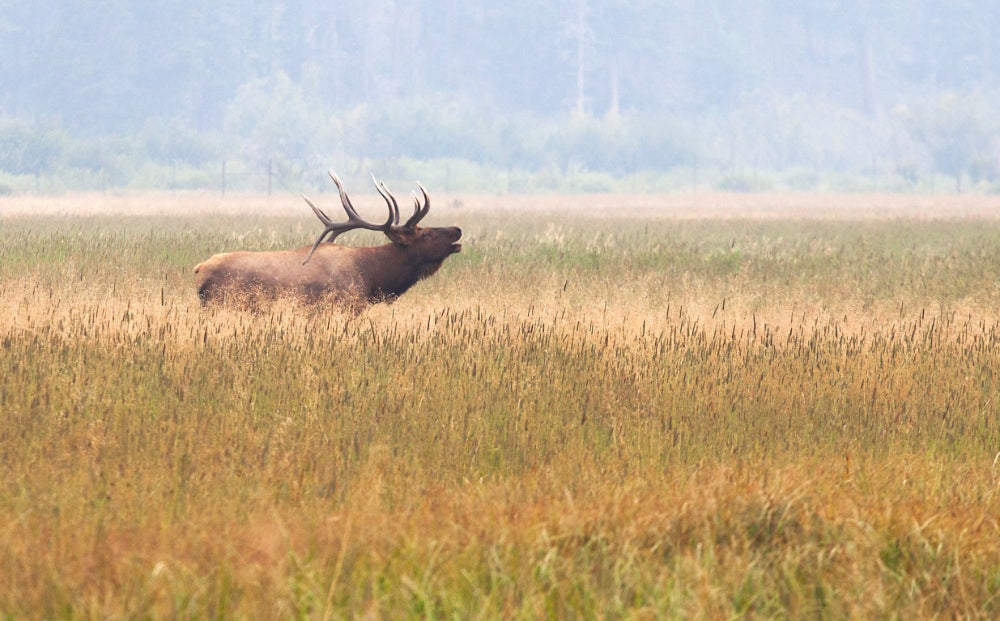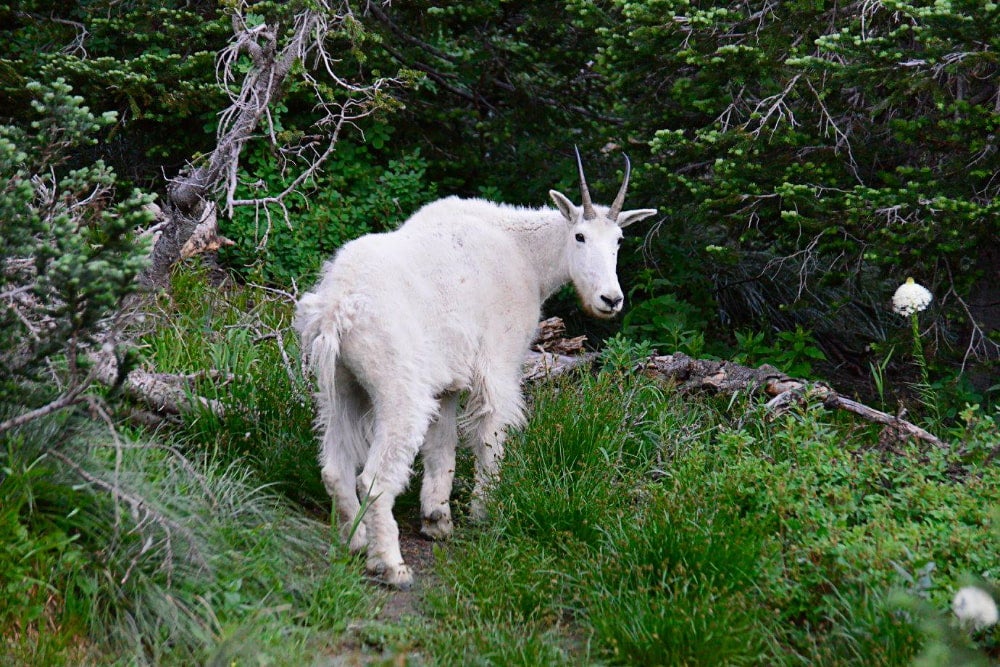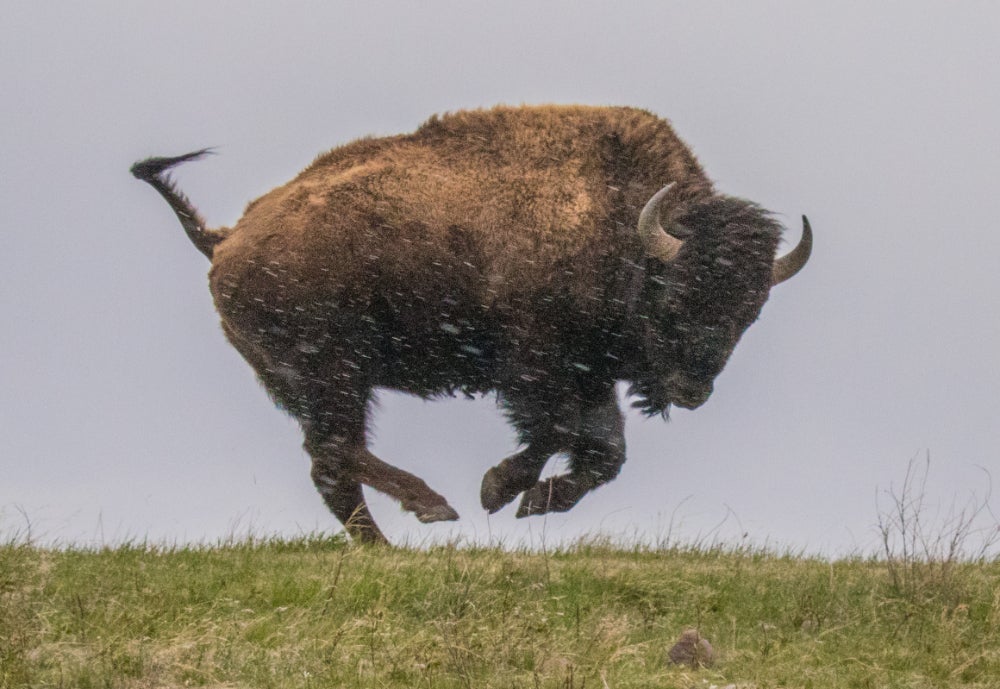In 2018 alone, we’ve seen thousands of wildlife photos in campground reviews from The Dyrt users. From American alligators in Mississippi, to grizzlies in Alaska, to elephant seals in California, we want to celebrate this collection as well as the wildlife enthusiasts who are exploring and reviewing campgrounds all over the country.
Top Wildlife Photos on The Dyrt
Thank you to all of The Dyrt campers for your contributions to helping remind us of the grandeur and beauty that come with our immensely biodiverse country. We love that campers are celebrating the beauty of nature, but remember to always consider safety while enjoying the outdoors and the wildlife it offers. Be aware of your surroundings, view wildlife respectfully, don’t get too close, and never feed wild animals.
Here are our favorite wildlife photos, courtesy of The Dyrt users.
1. Red Foxes — Willow Creek Campground, Colorado

Image from The Dyrt camper Amanda M.
Fun Fact: Red foxes use their thick tails to aid them in balance, warm themselves in cold weather, and communicate with other foxes.
About the campground: Willow Creek Campground is 14 miles from popular Grand Lake on the rim of Rocky Mountain National Park where you can also find elk herds, moose, and pronghorn and bighorn sheep.
“The campground was nice and quiet, without much noise pollution from the nearby road. The campers were all considerate with their noise levels, so it was a very peaceful stay. The park is very pretty, with lots of small trails. We found little clusters of aspen trees and saw deer and foxes on an evening walk. I got up early the next morning to see if I could photograph any wildlife, and found the foxes again!” –The Dyrt camper Amanda M.
2. American Moose – Gros Ventre Campground, Grand Teton National Park, Wyoming

Image from The Dyrt camper Deanna C.
Fun Fact: Male moose antlers can spread six feet from end to end.
About the campground: Gros Ventre Campground is centrally located between Grand Teton National Park for backpacking or kayaking and Jackson Hole for shopping and dining.
“If you’ve never been to Wyoming, you can’t imagine how beautiful this place is in the summer. Wildflowers everywhere, and once you get far enough into the park it feels like you’re somewhere no other people have ever been. The stars are crazy bright and the mountains are unreal. Definitely one of my favorite national parks. I would highly recommend taking a backpacking trip through the Tetons or doing some rock climbing. One of my all-time favorite campgrounds and favorite places.” –The Dyrt camper Sam M.
3. Orca Whale — San Juan Campground, Washington

Image from The Dyrt camper Amanda M.
Fun Fact: When hunting, Orcas can swallow sea lions and small seals whole.
About the campground: The San Juan Islands are an archipelago between Seattle and Canada where you have the opportunity to whale watch, sea kayak, explore beaches and much more.
“Camping at San Juan County Campground was one of my all-time favorite camping experiences! First of all – San Juan Island, WA, is gorgeous! …Before heading to the campground, we got some sandwiches in Friday Harbor, and took them with a bottle of wine to Limekiln Point State Park to see if we could spot any resident orca whales passing by. And we DID!!! According to the researchers at the Whale Museum…the orcas that we saw were the first resident orcas spotted that season!” —The Dyrt camper Amanda M.
4. Monarch Butterfly — Burlington Bay Campground, Minnesota

Image from The Dyrt camper Jutta P.
Fun Fact: North American monarchs migrate over 2,000 miles every year. When cold weather strikes in fall, monarchs leave Canada and Northern US states and travel south to southern California or central Mexico.
About the campground: Burlington Bay Campground is located on the beach of Burlington Bay in larger Lake Superior. Across the bay is Apostle Islands National Lakeshore where you can visit lighthouses, hike, sail, and paddle around these 21 islands.
“This campground is a perfect ‘home base’ for exploring Minnesota’s North Shore. The sites right on Lake Superior give you the opportunities to wake up every morning to a view of the lake as well as watching the big ships go to and from Two Harbors and Duluth. The campground is great for families – with a playground, beach and rock hunting along the shore.” –The Dyrt camper Kristen B.
5. Little White Whiptail — Alamogordo Campground, White Sands Nat. Park, New Mexico

Image from The Dyrt camper Brittany N.
Fun Fact: Some whiptail species are all female. Using a process called parthenogenesis, females eggs do not require fertilization. This results in all offspring being female and a genetic duplicate of their mothers.
About the campground: The Alamogordo KOA is located 17 miles from White Sands National Monument which boasts the world’s largest gypsum dunefield. The campground is one hour north of the Organ mountains, a jagged mountain range with hiking trails.
“One of the prettiest places in the U.S.A and the sand never gets hot!” –The Dyrt camper Brittany N.
6. Ruby-Throated Hummingbird — Harmonie State Park, Indiana

Image from The Dyrt camper Stephanie J.
Fun Fact: Ruby-throated hummingbirds beat their wings 53 times per second. The oldest known Ruby-throated hummingbird was 9 years old.
About the campground: Harmonie State Park is located along the Wabash River in Indiana. Here you can enjoy a picnic by the river or walk, hike, or bike on the park’s trails. Five miles north of the campground is Cathedral Labyrinth, an outdoor site which allows you to walk and meditate along a single path labyrinth. The pattern of this labyrinth is designed after the Chartres Cathedral, built in the 12th century outside of Paris, France.
“They have a nature center in the middle of the campground that is open Thursday-Sunday in the summer. There are 3 playgrounds throughout the campground. They have various events through the summer season with a big Halloween event in the fall. Most campsites are big and spacious, with several loops that allow campers to face one another.” —The Dyrt camper Olivia S.
7. Grebe — Cachuma Lake Recreation Area, California

Image from The Dyrt camper Amanda M.
Fun Fact: Although these birds can fly, when escaping danger they prefer to dive under water.
About the campground: Cachuma Lake is an easy 30 minutes drive north from Santa Barbara. The Santa Ynez and San Rafael Mountains stand tall in the background of the lake where you can camp, fish, and hike on 9,000 acres of recreation land.
“Cachuma Lake is a great place for wildlife viewing and birding. I am a photographer, and love seeing all of the birds that hang out around Cachuma – ducks, coots, Western and Clark’s grebes, loons, osprey, hawks, turkey vultures, turkeys, quail, American white pelicans, cormorants, etc. I have gotten my best birding photos at Cachuma Lake. Deer can often be viewed on the shores of the lake, and we have even seen bobcats and foxes. Pontoon boat tours to view wildlife launch every day from the marina.” —The Dyrt camper Amanda M.
8. Elk — Moraine Park Campground, Colorado

Image from The Dyrt camper Amanda M.
Fun Fact: According to a Shawnee Tribe legend, Elk are credited with the creation of the first flute. According to the story, a boy is too shy to talk to a girl he’s fallen in love with. Two elk-men visit the boy in a dream and give him a flute. He masters this flute and uses it to communicate his feelings for the girl using music.
About the campground: Moraine Park Campground provides ultimate access to Rocky Mountain National Park, being just 5 miles from the park entrance. Six miles east is Estes Park, a charming town lined with shops, restaurants, salt water taffy stores, and the infamous Stanley Hotel which inspired Stephan King’s The Shining.
“I camped during the Elk Rut and watching the elk come out at dusk was amazing. Hundred of elk at the meadow below. Jaw-dropping. Great campsite and great view. Even with plenty of RV’s and campers around it was extremely quiet. Each site had a picnic table and fire ring.” —The Dyrt camper Heather P.
9. Elephant Seals — San Simeon State Park, California

Image from The Dyrt camper Annie C.
Fun Fact: Male southern elephant seals can be over 20 feet long and weigh up to 8,000 pounds.
About the campground: Near the Pacific Coast Highway, this campground provides beautiful views of the California coast, and is only 1.5 hours from Big Sur State Park.
“This primitive but serene campground is right off Pacific Coast Highway. It’s just past the quaint town of Cambria and before Hearst Castle. Also nearby is the Elephant Seal overlook and a lighthouse, Piedras Blancas. The sites are large with lots of trees for shade.” —The Dyrt camper Michal S.
10. Mountain Goat — Johnson’s Campground, Montana

Image from The Dyrt camper Deanna C.
Fun Fact: Female mountain goats are also called “nannies.”
About the campground: Johnson’s campground is only half of a mile from ‘Going to The Sun Road’ in Glacier National Park where you’ll find magnificent glaciated peaks and valleys that extend into the Canadian border.
“Johnson’s Campground is conveniently located near the east entrance of Glacier National Park. Campsites are spread out and some do have electric available. Two coins are given for each campsite reservation. The showers are decent but small. It is near restaurants and stores in St. Mary. It is typically my last stop before crossing into Canada. I love staying here because I can get up early and get into the park, up to Logan’s Pass, before the crowds begin to filter in.” –The Dyrt camper Deanna C.
11. Bald Eagle — Townsend / Great Smokies KOA, Tennessee

Image from The Dyrt camper Matthew C.
Fun Fact: Bald eagles typically mate for life and share parenting duties such as incubating eggs and feeding their young. They can live up to 38 years.
About the campground: Townsend campground is 28 miles from the entrance of The Great Smoky Mountains National Park entrance. If you’re there in late May or Early June, you might have a chance to witness the natural phenomena of synchronous fireflies.
“This is a very well run quiet campground. We got a site right by the river with a patio deck. The campground is clean and well kept. Lovely playground for the kids. Right next to the entrance to the Great Smokey mountains. Townsend is a lovely town for eating and lots of walking trails. It is a short drive into pigeon forge if you want more activities to do. I highly recommend this full service campground.” –The Dyrt camper Tammy P.
12. Bison — Elk Mountain / Wind Cave National Park, South Dakota

Image from The Dyrt camper Shari G.
Fun Fact: In 1905, Teddy Roosevelt established the American Bison Society to help save disappearing Bison. As a result, Bison now live in nearly every state including Native American lands, wildlife refuges, national parks and private lands.
About the campground: Elk mountain campground is minutes from Wind Cave National Park where above ground you’ll have the opportunity to see bison and elk and below ground you can tour Wind Cave—one of the longest and most complex caves in the world.
“Great views of the nearby hills and spectacular evening and morning light! Wind caves is also an easy day’s drive from the Badlands and well worth getting off the main routes westward.” —The Dyrt camper Kelsey M.
13. Grizzly Bear — Camp Run-A-Muck, Alaska

Image from The Dyrt camper Deanna C.
Fun Fact: Grizzlies sometimes mate with polar bears. In parts of Alaska and Canada, there are rare sightings of “grolar bears” or “prizzlies,” the offspring of Polar Bears and Grizzlies.
About the campground: Camp Run-A-Muck is located outside of Hyder, Alaska, a small town near the border of British Colombia. Hyder provides easy access to Salmon Glacier in British Columbia and is 4 miles from Fish Creek, where there is a plethora of bear watching opportunity, especially during the salmon run.
“Camp Run-A-Muck is located in the ghost town of Hyder, Alaska. It is in the rainforest so surroundings are mountains and lush green trees and plants. The main attraction in Hyder is the bear viewing platform—perfect for taking wildlife photos—where brown bears and black bears (among other wildlife) gather for the salmon run in late summer/early fall. Black bears are commonly seen in and around town including the campground.” —The Dyrt camper Deanna C.
14. American alligator — Lake Lincoln State Park, Mississippi

Image from The Dyrt camper William H.
Fun Fact: Alligators have anywhere between 74-80 teeth in their jaws at any given time. Because their teeth wear down, fall out and then grow back, American alligators can go through over 2,000 teeth in their lifetime.
About the campground: Located an hour south of Jackson, Mississippi, Lake Lincoln State Park provides opportunities for boating, water skiing, fishing, and camping.
“Very nice campground with most of the amenities you could want. Very busy campground on holiday weekends. Camped very near the water. Sites are a little closer than I usually like but sites are nice and view of lake is great. We went in spring both times and bank fishing was exceptional. Friendly staff.” —The Dyrt camper Ronnie M.
15. Barred Owl — Brown County State Park, Indiana

Image from The Dyrt camper Rachel W.
Fun Fact: Barred owls sometimes have pink feathers on their belly. Studies suggest this may be due to eating a lot of crayfish.
About the campground: Brown County state park is nicknamed “Little Smokies” because of its resemblance to the Great Smoky Mountains. This state park boasts 16,000 acres of rugged hills and glaciers from recent ice ages. It’s a great spot for fall foliage along Lake Monroe, Indiana’s largest lake.
“The park that is set in massive hills and valleys has lots of different trails, a nature center, a pool, a lodge with a pool/park, large and small cabins for rent, various overlooks, playgrounds, historical sites, a fire watch tower you can go in, beautiful gathering places (large open cabins), daily activities throughout the park, a horse stables, amphitheaters, a restaurant, a gift store, and much more.” –The Dyrt camper Anna A.
16. Sea Star — Second Beach, Washington

Image from The Dyrt camper Lauren E.
Fun Fact: Sea stars are famous for their ability to regenerate limbs. Some species can grow an entirely new sea star from just a portion of a severed limb.
About the campground: Second Beach is located south of La Push, Washington. There’s a .7 mile hike to reach the campground, where campers can set up their tents in the sand. At lower tides, it’s possible to explore numerous tide pools and a natural arch on the north end of the beach.
“It just doesn’t get better than sleeping on sand. It is a short approach hike (less than a mile) through lush forest to get there. Tons of wildlife- assorted marine mammals, tide pools, and a few eagles! There are natural bridges and other cool rock formations including tall cartoon-like islands just offshore. Bring your own water!” –The Dyrt camper Kelly M.
17. Bighorn Sheep — Cedar Mesa, Capitol Reef National Park, Utah

Image from The Dyrt camper Rob F.
Fun Fact: Because of their balance-aiding hooves, bighorn sheep can stand on ledges that are only 5 centimeters wide.
About the campground: Cedar Mesa is 21 miles south of Capitol Reef National Park where you’ll find 243,921 acres of exploration including hiking, wildlife-viewing, horseback riding, and rock climbing.
“It’s the only place to camp in the very scenic southern end of the Park. There are only five sites. All have a fire ring and picnic table. There’s a vault toilet, but no water or firewood so you must bring your own. It’s also the trailhead for the superb short Red Canyon Trail…” — The Dyrt camper Rob F.
18. Yetta / Cloud Horse — Our Loveable ‘The Dyrt’ Office Dog – The Dyrt

Image from Yetta’s Dog-Dad Anthony E.
Fun Fact: Yetta originally had two names when she was adopted. Ariel and Loretta. But being worthy of a stronger name, “Yetta” was chosen.
About The Dyrt: The best ever platform for all of your camping needs—but you knew that!
“Yetta and I have a great companionship. She really enjoys sleeping, slumbering, siesta-ing, taking naps, laying down, closing her eyes, twitching, snoozing, saying hello to Mr. Sandman, hitting the hay, being tuckered out, dreaming, and sailing off to Snoozeville.” —Yetta’s Dog-Dad, Anthony.
The Dyrt is the only camping app with all of the public and private campgrounds, RV parks, and free camping locations in the United States. Download now for iOS and Android.Popular Articles:
Articles on The Dyrt Magazine may contain links to affiliate websites. The Dyrt receives an affiliate commission for any purchases made by using such links at no additional cost to you the consumer.


